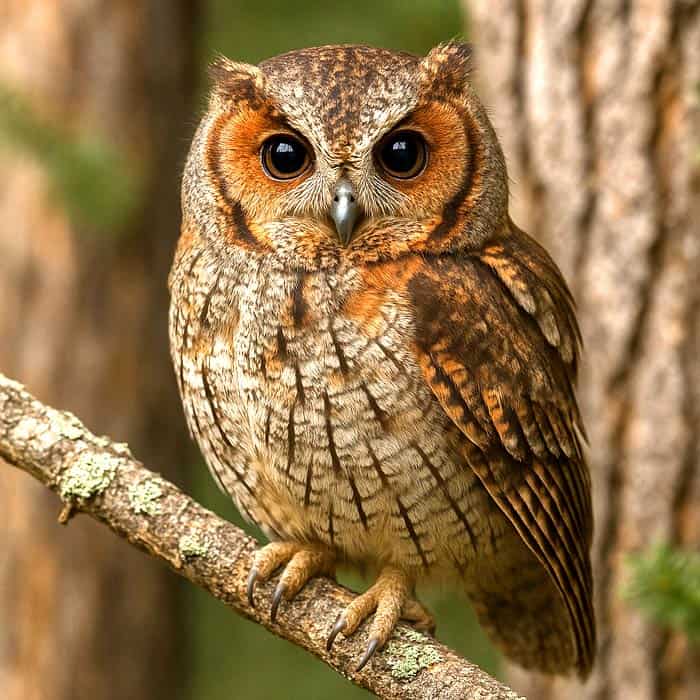
| Animalia | Strigiformes | Strigidae | Psiloscops | Psiloscops flammeolus |
The flammulated owl (Psiloscops flammeolus) is a small, nocturnal bird native to western North America, renowned for its elusive nature and distinctive vocalizations. Despite its widespread range, this species remains one of the least understood types of owls due to its secretive habits and preference for dense forest habitats.
Table of Contents
- Common Name: Flammulated owl.
- Family: Strigidae
- Body Dimensions: 15 to 17 cm in length, 36 to 42 cm in wingspan.
- Male Plumage Colors: Rusty-red and gray, mottled.
- Female Plumage Colors: Rusty-red and gray, mottled.
- Habitat: Open coniferous or mixed forests.
- Diet: Mostly nocturnal insects.
- Native Countries: Canada, United States, Mexico.
- Continent: North America
- IUCN Status: Least Concern.

The name “flammulated” refers to the flame-like markings on its face and body, which provide excellent camouflage among the bark and leaves of its preferred woodland environments.
Flammulated Owl Characteristics
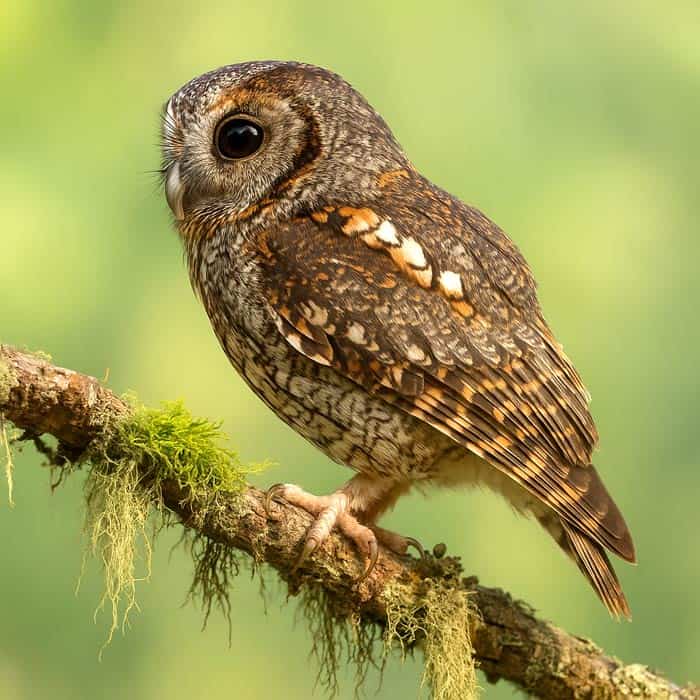
The flammulated owl is among the smallest owls in North America, measuring about 6 inches in length and weighing around 1.6 to 2.2 ounces.
- Its plumage is predominantly grayish-brown with intricate streaks and spots, providing remarkable camouflage against tree bark.
- Unlike many other small owls, the flammulated owl has dark brown eyes. This distinguishing feature sets it apart from its relatives, which have yellow or orange eyes.
- Its facial disk is bordered by a thin, dark rim, and it has small, inconspicuous ear tufts that are often barely visible.
- The owl’s wings are relatively long and rounded, allowing for agile flight through dense forests.
- Its tail is short, and its feet are feathered only halfway down the toes, which is typical for owls that do not hunt in snowy environments.
- The bill is small, grayish, and hooked, adapted for capturing and consuming insects.
- Sexual dimorphism is minimal in this species, with males and females appearing similar, though females are slightly larger on average.
These physical adaptations, combined with their cryptic coloration, make flammulated owls difficult to spot in their natural habitat, especially during daylight hours when they are roosting against tree trunks.
Flammulated Owl Habitat
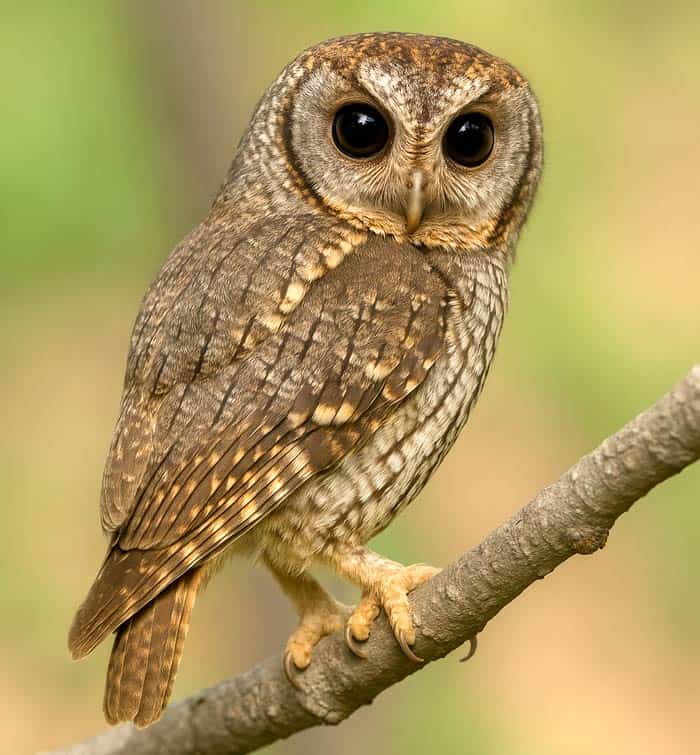
Flammulated owls are closely associated with mature, open coniferous forests, particularly those dominated by ponderosa pine, Douglas-fir, and mixed conifer species.
- They prefer habitats with a mosaic of large trees for nesting and open areas for foraging. Elevations typically range from 3000 to 9800 feet, with the species favoring mountainous regions in the western United States, southern British Columbia, and parts of northern Mexico during the breeding season.
- These owls are cavity nesters, relying on natural tree cavities or those excavated by woodpeckers, particularly in older forests with standing dead trees, known as “snags”.
- The presence of such cavities is a critical factor in their habitat selection. During migration and winter, flammulated owls move to lower elevations and more southerly locations, occupying a variety of forested habitats in Mexico and Central America.
Their dependence on mature forests and snags makes them vulnerable to logging, fire suppression, and other forms of habitat alteration.
What Do Flammulated Owls Eat?
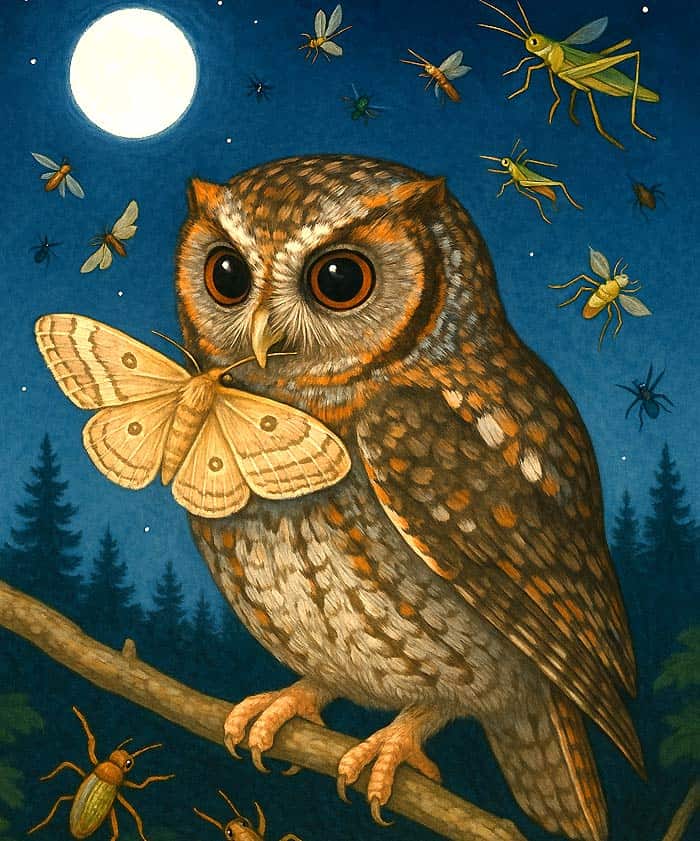
The flammulated owl is a specialized insectivore, feeding primarily on nocturnal insects.
- Its diet consists mainly of moths, beetles, crickets, grasshoppers, and other large arthropods. Occasionally, it may consume spiders or small vertebrates, but these are a minor component of its diet.
- The owl hunts by perching quietly and scanning for prey, then swooping down to capture insects either in flight or from foliage.
Foraging activity peaks shortly after dusk and before dawn, coinciding with the activity patterns of its insect prey.
- The owl’s acute hearing and vision, along with its silent flight, make it an effective nocturnal hunter.
- Its reliance on insect prey links its population dynamics closely to the abundance of forest insects, which can fluctuate in response to weather and habitat conditions.
Overall, this dietary specialization highlights the owl’s crucial role in maintaining the ecological balance of its forest environment by regulating insect populations.
Suggested Reading:
What Do Owls Eat?
What Eats Flammulated Owls?
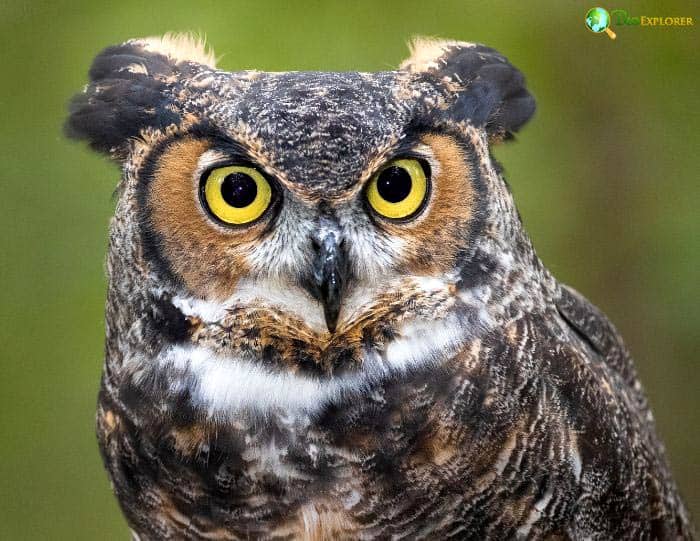
The flammulated owl has several predators in the wild.
- Larger owls, such as the great horned owl and northern saw-whet owl, may prey on flammulated owls, especially during the nesting season when adults and young are more vulnerable.
- Other avian predators, including hawks and certain types of corvids, could also pose a threat, particularly to eggs and nestlings.
- Mammalian predators such as raccoons, squirrels, and weasels may raid nests to consume eggs or young owlets.
- Snakes are another possible nest predator, especially in areas where tree cavities are accessible.
The owl’s coloration and secretive behavior help reduce the risk of predation, as does its tendency to nest in cavities high above the ground. However, habitat disturbances that reduce the availability of suitable nesting sites or increase exposure can elevate predation risks for this species.
Breeding Behavior
Flammulated owls are migratory breeders, arriving at their nesting grounds in late spring after wintering in Mexico and Central America.
- The breeding season typically begins in May or June, with males establishing territories and attracting females through a distinctive low-pitched “boo-boo-boo” call that can carry over long distances.
- Territorial males often call persistently at night, especially during the early breeding season.
Once a pair forms, they select a nesting site, almost always a natural cavity or an old woodpecker hole in a large, mature tree.
- The female lays 2-4 eggs, which she incubates alone for about 21-24 days while the male provides food.
- During incubation, the female remains in the nest cavity, relying on the male to deliver insects, primarily moths and beetles.
- After hatching, both parents feed the chicks, which remain in the nest for approximately 22 to 25 days before fledging.
- Nestlings are altricialWhat is altricial?Altricial animals are born in an underdeveloped state, unable to see, move well, or feed themselves. For example, many songbirds hatch blind and featherless, relying entirely on their parents for warmth and food., hatching blind and helpless, and require constant care and feeding. Fledglings remain near the nest for several weeks, gradually learning to hunt under parental supervision.
Flammulated owls typically produce only one brood per year, reflecting the relatively short breeding season in their mountainous habitats. Successful breeding depends on the availability of suitable nest cavities and an abundance of insect prey, making the species sensitive to changes in forest structure and food supply.
Ecological Importance
As mentioned previously, the Flammulated Owl is currently listed as a species of Least Concern by the IUCN; however, its populations are considered vulnerable in parts of its range due to habitat loss and degradation.
- The primary threats to the species include logging, fire suppression, and the removal of standing dead trees, which reduce the availability of nesting sites.
- Conservation efforts focus on maintaining and restoring mature forest habitats that feature a diverse mix of tree species and ample snags for nesting.
The flammulated owl serves as an indicator speciesWhat is indicator species?An indicator species is an organism whose presence, absence, or abundance reflects the health or quality of its environment. for healthy, mature forests, and its presence reflects the ecological integrity of these environments. Protecting this owl helps conserve a wide range of other forest-dependent species, supporting overall biodiversity.
Flammulated Owl Fun Facts
- The flammulated owl is one of the smallest owls in North America, weighing less than a standard deck of cards.
- Despite its tiny size, its voice is surprisingly deep and low-pitched, often mistaken for a much larger owl.
- Their dark brown eyes are unusual among North American owls, most of which have yellow or orange eyes.
- These owls are strictly nocturnal, rarely seen during the day, and most active just after sunset and before sunrise.
- This species’ soft, cryptic plumage allows them to blend seamlessly into tree bark, making them difficult to spot even when roosting in plain sight.
Frequently Asked Questions
Why is the flammulated owl so hard to spot in the wild?
The flammulated owl’s coloration and small size make it exceptionally well-camouflaged against tree bark, especially in its preferred coniferous forests. Additionally, its nocturnal habits mean it is rarely active during daylight hours, further reducing the chances of being seen by birdwatchers or researchers.
How far do flammulated owls migrate each year?
Flammulated owls are long-distance migrants traveling from breeding grounds in western North America to wintering areas in Mexico and Central America. Some individuals may migrate over 1900 miles between seasons.
Flammulated owls are generally solitary outside of the breeding season. During breeding, pairs form and defend territories, but otherwise, they do not form flocks or social groups.
Do flammulated owls use the same nest every year?
While flammulated owls may return to the same territory in subsequent years, they do not always use the same nest cavity. The availability of suitable cavities and competition with other cavity-nesting species can influence nest site selection each year.
How do flammulated owls avoid predators?
These owls rely on their excellent camouflage and secretive behavior to avoid detection. Nesting in high tree cavities and remaining motionless during the day also help reduce predation risk from birds and Mammals.
Are flammulated owls affected by forest fires?
Forest fires can have both positive and negative effects. While intense fires may destroy habitat, low-intensity fires can create snags and open forest structures, which may benefit the species by increasing nesting sites and foraging opportunities.
The flammulated owl is a remarkable species that embodies the complexity and beauty of North America’s western forests.
Its small size, cryptic appearance, and nocturnal habits make it a challenging subject for study. Yet, its ecological importance as an insect predator is undeniable. By protecting the forests that sustain this species, we also support a rich diversity of wildlife and maintain the health of vital ecosystems.
![]()












